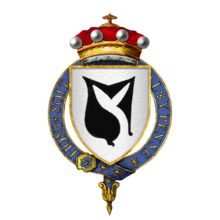William Hastings, 1st Baron Hastings
| The Right Honourable The Lord Hastings KG |
|
|---|---|

Arms of Sir William Hastings, 1st Baron Hastings, KG
|
|
| Spouse(s) | Katherine Neville |
|
Issue
Edward Hastings, 2nd Baron Hastings
Sir William Hastings Sir Richard Hastings George Hastings Anne Hastings, Countess of Shrewsbury Elizabeth Hastings |
|
| Noble family | Hastings |
| Father | Sir Leonard Hastings |
| Mother | Alice Camoys |
| Born | c.1431 |
| Died | 13 June 1483 Tower of London |
William Hastings, 1st Baron Hastings KG (c. 1431 – 13 June 1483) was an English nobleman. A loyal follower of the House of York during the Wars of the Roses, he became a close friend and one of the most important courtiers of King Edward IV, whom he served as Lord Chamberlain. At the time of Edward's death he was one of the most powerful and richest men in England. He was summarily executed following accusations of treason by Edward's brother and ultimate successor, Richard III.
William Hastings, born about 1431, was the eldest son of Sir Leonard Hastings (c.1396 – 20 October 1455), and his wife Alice Camoys, daughter of Thomas de Camoys, 1st Baron Camoys. Hastings succeeded his father in service to the House of York and through this service became close to his distant cousin the future Edward IV, whom he was to serve loyally all his life. He was High Sheriff of Warwickshire and High Sheriff of Leicestershire in 1455.
He fought alongside Edward at the Battle of Mortimer's Cross and was present at the proclamation of Edward as king in London on 4 March 1461 and then when the new king secured his crown at the Battle of Towton shortly thereafter. He was knighted on the field of battle. With the establishment of the Yorkist regime, Hastings became one of the key figures in the realm, most importantly as Master of the Mint and Lord Chamberlain, an office he held for the duration of the reign and which made him one of the most important means of access to the king. He was also created Baron Hastings, a title reinforced by grants of land and office, primarily in Leicestershire and Northamptonshire. In 1462 he was invested as a Knight of the Garter.
...
Wikipedia
